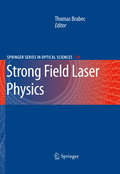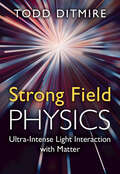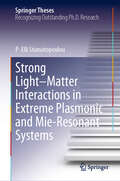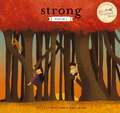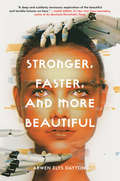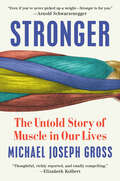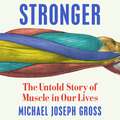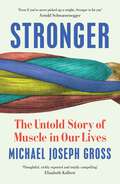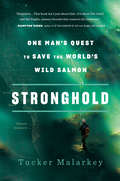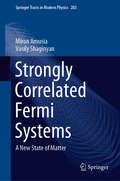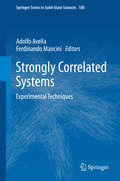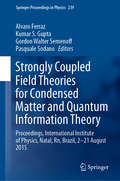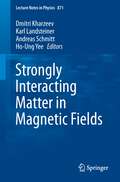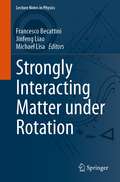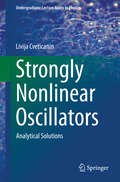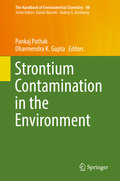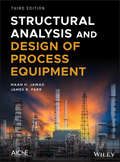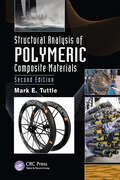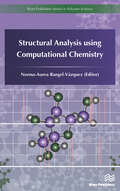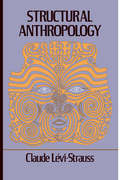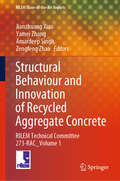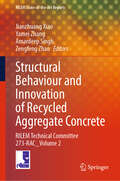- Table View
- List View
Strong Field Laser Physics
by Thomas BrabecDue to the rapid progress in laser technology a wealth of novel fundamental and applied applications of lasers in atomic and plasma physics have become possible. This book focuses on the interaction of high intensity lasers with matter. It reviews the state of the art of high power laser sources, intensity laser-atom and laser-plasma interactions, laser matter interaction at relativistic intensities, and QED with intense lasers.
Strong Field Physics: Ultra-Intense Light Interaction with Matter
by Todd DitmireThis book presents the foundational physics underlying the generation of high intensity laser light and its interaction with matter. Comprehensive and rigorous, it describes how the strong electric and magnetic fields of a high intensity light pulse can shape the nonlinear dynamics of all forms of matter, from single electrons up to atomic clusters and plasmas. Key equations are derived from first principles and important results are clearly explained, providing readers with a firm understanding of the fundamental concepts that underlie modern strong field physics research. The text concludes with suggestions for further reading, along with an extensive reference list. Effective as both an educational resource and as a reference text, this book will be invaluable to graduates and researchers across the atomic, molecular and optical (AMO) and plasma physics communities.
Strong Light–Matter Interactions in Extreme Plasmonic and Mie-Resonant Systems (Springer Theses)
by P. Elli StamatopoulouCollective excitations in matter, either in the form of plasmons in metals or Mie resonances in high-index dielectrics, constitute fundamental building blocks for photonic applications, including optical and quantum communications, biosensing, and polaritonic chemistry. Motivated by these prospects, this book explores excitations sustained in metallic and dielectric nanocavities and their interaction with light, quantum emitters, and swift electrons. The book presents analytic methods for describing the strong and weak coupling between spherical nanocavities and optical transitions in matter, while also analyzing the impact of nonlocality on the coupling, when considering extremely small metallic structures. Besides light-based spectroscopy, it examines electrons as sources for probing optical excitations in matter and provides analytic tools for simulating measurements in cathodoluminescence and electron energy-loss spectroscopy.
Strong: Psalm 1
by Sally Lloyd-JonesInspired by Psalm 1, Strong&’s lyrical text reminds little ones that God loves them and gives them strength. From Sally Lloyd-Jones, the author of the bestselling The Jesus Storybook Bible, and award-winning illustrator Jago, this uplifting board book encourages little ones to find strength in God&’s great love for them.Like a little tree planted by a fresh stream, children can grow strong and joyful when they draw close to God&’s Never Stopping, Never Giving Up, Unbreaking, Always and Forever Love.Strong is perfect for babies and infants ages 0-4 and features:Lyrical text inspired by Psalm 1An inspiring message that reminds kids they can find strength, joy, and love in GodA padded cover that is a perfect fit for little handsBeautiful illustrations by JagoA great gift for a new baby, Baptism, First Communion, or birthday Look for additional inspirational stories for little ones in this board book series inspired by The Jesus Storybook Bible:Happy: Psalm 92Known: Psalm 139Near: Psalm 139Loved: The Lord&’s PrayerFound: Psalm 23
Stronger, Faster, and More Beautiful
by Arwen Elys Dayton<P><P>For fans of television shows Black Mirror and Westworld, this compelling, mind-bending novel is a twisted look into the future, exploring the lengths we'll go to remake ourselves into the perfect human specimen and what it means to be human at all. <P><P>The future is curious. <P><P>STRONGER <P><P>Today our bodies define us. We color our hair; tattoo our skin; pierce our ears, brows, noses. We lift weights, run miles, break records. We are flesh and blood and bone. <P><P>FASTER <P><P>Tomorrow has different rules. The future is no longer about who we are--it's about who we want to be. If you can dream it, you can be it. Science will make us smarter, healthier, flawless in every way. Our future is boundless. <P><P>MORE BEAUTIFUL <P><P>This is a story that begins tomorrow. It's a story about us. It's a story about who comes after us. And it's a story about perfection. Because perfection has a way of getting ugly.
Stronger: The Untold Story of Muscle in Our Lives
by Michael Joseph GrossA groundbreaking, richly informative exploration of the central role of muscle in human life and health, Stronger sounds an urgent call for each of us to recognize muscle as &“the vital, inextricable and effective partner of the soul.&” &“Even if you&’ve never picked up a weight—Stronger is for you.&” —Arnold SchwarzeneggerStronger tells a story of breathtaking scope, from the battlefields of the Trojan War in Homer&’s Iliad, where muscles enter the scene of world literature; to the all-but-forgotten Victorian-era gyms on both sides of the Atlantic, where women build strength and muscle by lifting heavy weights; to a retirement home in Boston, where a young doctor makes the astonishing discovery that frail ninety-year-olds can experience the same relative gains of strength and muscle as thirty-year-olds if they lift weights. These surprising tales play out against a background of clashing worldviews, an age-old competition between athletic trainers and medical doctors to define our understanding and experience of muscle. In this conflict, muscle got typecast: Simplistic binaries of brain versus brawn created a persistent prejudice against muscle, and against weight training, the type of exercise that best builds muscular strength and power. Stronger shows muscle and weight training in a whole new light. With warmth and humor, Michael Joseph Gross blends history and firsthand reporting in an inspiring narrative packed with practical information based on rigorous scientific studies from around the world. The research proves that weight training can help prevent or treat many chronic diseases and disabilities throughout the lifespan, including cardiovascular disease, cancer, type 2 diabetes, osteoarthritis, and depression. Stronger reveals how all of us, from elite powerlifters to people who have never played sports at all, can learn to lift weights in ways that yield life's ultimate prize: the ability to act upon the world in the ways that we wish.
Stronger: The Untold Story of Muscle in Our Lives
by Michael Joseph Gross'Even if you've never picked up a weight, Stronger is for you' - Arnold SchwarzeneggerNo matter how you think of yourself - strong or weak, large or small - you are substantially made of muscle. To the last day of your life, your ability to stand and go where you want to go, your agency and effectiveness in the world, will depend on it. But what is muscle?From the battlefields of Homer's Iliad, where muscles first entered world literature, to the Victorian-era gymnasiums where women built strength and muscle by lifting heavy weights, to a retirement home in Boston, where a young doctor discovered that training at high intensity can produce the same relative gains for frail ninety-year-olds as for thirty-year-olds, Stronger places the science and significance of our muscles in an astonishing new light.Ancient binaries of brain versus brawn created an enduring prejudice against muscle, and against the type of exercise that best builds strength. Yet the research proves that weight training can help prevent or treat many chronic diseases and disabilities throughout life, including depression, cancer, and diabetes. All of us, from elite powerlifters to people who have never played sports at all, can learn to lift weights in ways that yield life's ultimate prize: the ability to act in the world.
Stronger: The Untold Story of Muscle in Our Lives
by Michael Joseph Gross'Even if you've never picked up a weight, Stronger is for you' - Arnold SchwarzeneggerNo matter how you think of yourself - strong or weak, large or small - you are substantially made of muscle. To the last day of your life, your ability to stand and go where you want to go, your agency and effectiveness in the world, will depend on it. But what is muscle?From the battlefields of Homer's Iliad, where muscles first entered world literature, to the Victorian-era gymnasiums where women built strength and muscle by lifting heavy weights, to a retirement home in Boston, where a young doctor discovered that training at high intensity can produce the same relative gains for frail ninety-year-olds as for thirty-year-olds, Stronger places the science and significance of our muscles in an astonishing new light.Ancient binaries of brain versus brawn created an enduring prejudice against muscle, and against the type of exercise that best builds strength. Yet the research proves that weight training can help prevent or treat many chronic diseases and disabilities throughout life, including depression, cancer, and diabetes. All of us, from elite powerlifters to people who have never played sports at all, can learn to lift weights in ways that yield life's ultimate prize: the ability to act in the world.
Stronghold: One Man's Quest to Save the World's Wild Salmon
by Tucker Malarkey“A powerful and inspiring story. Guido Rahr’s mission to save the wild Pacific salmon leads him into adventures that make for a breathtakingly exciting read.”—Ian Frazier, author of Travels in Siberia In the tradition of Mountains Beyond Mountains and The Orchid Thief, Stronghold is Tucker Malarkey’s eye-opening account of an unlikely visionary and his crusade to protect the world’s last bastion of wild salmon. From a young age, Guido Rahr was a misfit among his family and classmates, preferring to spend his time in the natural world. An obsessive fly fisherman, Rahr noticed when the salmon runs of the Pacific Northwest began to decline—and was one of the few who understood why. As dams, industry, and climate change degraded the homes of these magnificent fish, Rahr saw that the salmon of the Pacific Rim were destined to go the way of their Atlantic brethren: near extinction. An improbable and inspiring story, Stronghold takes us on a wild adventure, from Oregon to Alaska to one of the world’s last remaining salmon strongholds in the Russian Far East, a landscape of ecological richness and diversity that is rapidly being developed for oil, gas, minerals, and timber. Along the way, Rahr contends with scientists, conservationists, Russian oligarchs, corrupt officials, and unexpected allies in an attempt to secure a stronghold for the endangered salmon, an extraordinary keystone species whose demise would reverberate across the planet.Tucker Malarkey, who joins Rahr in the Russian wilderness, has written a clarion call for a sustainable future, a remarkable work of natural history, and a riveting account of a species whose future is closely linked to our own.Advance praise for Stronghold“This book isn’t just about fish, it’s about life itself and the fragile unseen threads that connect all creatures across this beleaguered orb we call home. Guido Rahr’s quest to save the world’s wild salmon should serve as an inspiration—and a provocation—for us all, and Tucker Malarkey’s exquisite book captures Rahr’s weird and wonderful story with poignancy, humor, and grace.”—Hampton Sides, author of In the Kingdom of Ice and Blood and Thunder“A crazy-good, intensely lived book that reads like an international thriller—only it’s our beloved salmon playing the part of diamonds or oil or gold.”—David James Duncan, author of The River Why and The Brothers K
Strongly Correlated Fermi Systems: A New State of Matter (Springer Tracts in Modern Physics #283)
by Miron Amusia Vasily ShaginyanThis book focuses on the topological fermion condensation quantum phase transition (FCQPT), a phenomenon that reveals the complex behavior of all strongly correlated Fermi systems, such as heavy fermion metals, quantum spin liquids, quasicrystals, and two-dimensional systems, considering these as a new state of matter. The book combines theoretical evaluations with arguments based on experimental grounds demonstrating that the entirety of very different strongly correlated Fermi systems demonstrates a universal behavior induced by FCQPT. In contrast to the conventional quantum phase transition, whose physics in the quantum critical region are dominated by thermal or quantum fluctuations and characterized by the absence of quasiparticles, the physics of a Fermi system near FCQPT are controlled by a system of quasiparticles resembling the Landau quasiparticles. The book discusses the modification of strongly correlated systems under the action of FCQPT, representing the “missing” instability, which paves the way for developing an entirely new approach to condensed matter theory; and presents this physics as a new method for studying many-body objects. Based on the authors’ own theoretical investigations, as well as salient theoretical and experimental studies conducted by others, the book is well suited for both students and researchers in the field of condensed matter physics.
Strongly Correlated Systems
by Ferdinando Mancini Adolfo AvellaThis volume presents, for the very first time, an exhaustive collection of those modern numerical methods specifically tailored for the analysis of Strongly Correlated Systems. Many novel materials, with functional properties emerging from macroscopic quantum behaviors at the frontier of modern research in physics, chemistry and material science, belong to this class of systems. Any technique is presented in great detail by its own inventor or by one of the world-wide recognized main contributors. The exposition has a clear pedagogical cut and fully reports on the most relevant case study where the specific technique showed to be very successful in describing and enlightening the puzzling physics of a particular strongly correlated system. The book is intended for advanced graduate students and post-docs in the field as textbook and/or main reference, but also for other researchers in the field who appreciate consulting a single, but comprehensive, source or wishes to get acquainted, in a as painless as possible way, with the working details of a specific technique.
Strongly Coupled Field Theories for Condensed Matter and Quantum Information Theory: Proceedings, International Institute of Physics, Natal, Rn, Brazil, 2–21 August 2015 (Springer Proceedings in Physics #239)
by Alvaro Ferraz Kumar S. Gupta Gordon Walter Semenoff Pasquale SodanoThis book presents a selection of advanced lectures from leading researchers, providing recent theoretical results on strongly coupled quantum field theories. It also analyzes their use for describing new quantum states, which are physically realizable in condensed matter, cold-atomic systems, as well as artificial materials. It particularly focuses on the engineering of these states in quantum devices and novel materials useful for quantum information processing. The book offers graduate students and young researchers in the field of modern condensed matter theory an updated review of the most relevant theoretical methods used in strongly coupled field theory and string theory. It also provides the tools for understanding their relevance in describing the emergence of new quantum states in a variety of physical settings. Specifically, this proceedings book summarizes new and previously unrelated developments in modern condensed matter physics, in particular: the interface of condensed matter theory and quantum information theory; the interface of condensed matter physics and the mathematics emerging from the classification of the topological phases of matter, such as topological insulators and topological superconductors; and the simulation of condensed matter systems with cold atoms in optical lattices.
Strongly Interacting Matter in Magnetic Fields
by Karl Landsteiner Andreas Schmitt Dmitri Kharzeev Ho-Ung YeeThe physics of strongly interacting matter in an external magnetic field is presently emerging as a topic of great cross-disciplinary interest for particle, nuclear, astro- and condensed matter physicists. It is known that strong magnetic fields are created in heavy ion collisions, an insight that has made it possible to study a variety of surprising and intriguing phenomena that emerge from the interplay of quantum anomalies, the topology of non-Abelian gauge fields, and the magnetic field. In particular, the non-trivial topological configurations of the gluon field induce a non-dissipative electric current in the presence of a magnetic field. These phenomena have led to an extended formulation of relativistic hydrodynamics, called chiral magnetohydrodynamics. Hitherto unexpected applications in condensed matter physics include graphene and topological insulators. Other fields of application include astrophysics, where strong magnetic fields exist in magnetars and pulsars. Last but not least, an important new theoretical tool that will be revisited and which made much of the progress surveyed in this book possible is the holographic principle - the correspondence between quantum field theory and gravity in extra dimensions. Edited and authored by the pioneers and leading experts in this newly emerging field, this book offers a valuable resource for a broad community of physicists and graduate students.
Strongly Interacting Matter under Rotation (Lecture Notes in Physics #987)
by Francesco Becattini Jinfeng Liao Michael LisaThis book addresses the needs of growing community of graduate students and researchers new to the area, for a survey that covers a wide range of pertinent topics, summarizes the current status of the field, and provides the necessary pedagogical materials for newcomers. The investigation of strongly interacting matter under the influence of macroscopic rotational motion is a new, emerging area of research that encompasses a broad range of conventional physics disciplines such as nuclear physics, astrophysics, and condensed matter physics, where the non-trivial interplay between global rotation and spin is generating many novel phenomena. Edited and authored by leading researchers in the field, this book covers the following topics: thermodynamics and equilibrium distribution of rotating matter; quantum field theory and rotation; phase structure of QCD matter under rotation; kinetic theory of relativistic rotating matter; hydrodynamics with spin; magnetic effects in fluid systems with high vorticity and charge; polarization measurements in heavy ion collisions; hydrodynamic modeling of the QCD plasma and polarization calculation in relativistic heavy ion collisions; chiral vortical effect; rotational effects and related topics in neutron stars and condensed matter systems.
Strongly Nonlinear Oscillators
by Livija CveticaninThis book provides the presentation of the motion of pure nonlinear oscillatory systems and various solution procedures which give the approximate solutions of the strong nonlinear oscillator equations. The book presents the original author's method for the analytical solution procedure of the pure nonlinear oscillator system. After an introduction, the physical explanation of the pure nonlinearity and of the pure nonlinear oscillator is given. The analytical solution for free and forced vibrations of the one-degree-of-freedom strong nonlinear system with constant and time variable parameter is considered. Special attention is given to the one and two mass oscillatory systems with two-degrees-of-freedom. The criteria for the deterministic chaos in ideal and non-ideal pure nonlinear oscillators are derived analytically. The method for suppressing chaos is developed. Important problems are discussed in didactic exercises. The book is self-consistent and suitable as a textbook for students and also for professionals and engineers who apply these techniques to the field of nonlinear oscillations.
Strontium Contamination in the Environment (The Handbook of Environmental Chemistry #88)
by Dharmendra K. Gupta Pankaj PathakThis book provides an authoritative review of the origin and extraction of strontium and its impact on the environment. It also presents the latest strontium decontamination and remediation strategies. Around the globe, nuclear power is being recognized as a major source of energy and is expected to play a crucial role in meeting the energy requirements of present day society. However, the pros and cons have to be considered, and the safe disposal of large amounts of radionuclide wastes is becoming a matter of great concern. These wastes encompass contaminants such as heavy metals and toxic substances, which may exist in solid, liquid or gaseous forms or a combination of these, and as such, their disposal requires particular attention. The book focuses on 90Sr, which is a predominant isotope of strontium and considered an intermediate level radioactive waste with a half-life of 28.8 years, average biological half-life of 18 years and 546 KeV decay energy. Written by expert contributors, it addresses occurrence, detection and extraction of strontium, the chemical and nuclear properties of strontium isotopes, the fate and migration of strontium in soil, its bioaccumulation, and its associated health impact, mechanistic toxicity response as well as related regulation and remediation. It appeals to scholars, scientists and environmental managers working with strontium contamination in the environment and its consequences.
Structural Analysis and Design of Process Equipment
by James R. Farr Maan H. JawadStill the only book offering comprehensive coverage of the analysis and design of both API equipment and ASME pressure vessels This edition of the classic guide to the analysis and design of process equipment has been thoroughly updated to reflect current practices as well as the latest ASME Codes and API standards. In addition to covering the code requirements governing the design of process equipment, the book supplies structural, mechanical, and chemical engineers with expert guidance to the analysis and design of storage tanks, pressure vessels, boilers, heat exchangers, and related process equipment and its associated external and internal components. The use of process equipment, such as storage tanks, pressure vessels, and heat exchangers has expanded considerably over the last few decades in both the petroleum and chemical industries. The extremely high pressures and temperatures involved with the processes for which the equipment is designed makes it potentially very dangerous to property and life if the equipment is not designed and manufactured to an exacting standard. Accordingly, codes and standards such as the ASME and API were written to assure safety. Still the only guide covering the design of both API equipment and ASME pressure vessels, Structural Analysis and Design of Process Equipment, 3rd Edition: Covers the design of rectangular vessels with various side thicknesses and updated equations for the design of heat exchangers Now includes numerical vibration analysis needed for earthquake evaluation Relates the requirements of the ASME codes to international standards Describes, in detail, the background and assumptions made in deriving many design equations underpinning the ASME and API standards Includes methods for designing components that are not covered in either the API or ASME, including ring girders, leg supports, and internal components Contains procedures for calculating thermal stresses and discontinuity analysis of various components Structural Analysis and Design of Process Equipment, 3rd Edition is an indispensable tool-of-the-trade for mechanical engineers and chemical engineers working in the petroleum and chemical industries, manufacturing, as well as plant engineers in need of a reference for process equipment in power plants, petrochemical facilities, and nuclear facilities.
Structural Analysis in the Social Sciences: Illuminating Dark Networks
by Luke M. GerdesSome of the most important international security threats stem from terror groups, criminal enterprises, and other violent non-state actors (VNSAs). Because these groups are often structured as complex, dark networks, analysts have begun to use network science to study them. However, standard network tools were originally developed to examine companies, friendship groups, and other transparent networks. The inherently clandestine nature of dark networks dictates that conventional analytical tools do not always apply. Data on dark networks is incomplete, inaccurate, and often just difficult to find. Moreover, dark networks are often organized to undertake fundamentally different tasks than transparent networks, so resources and information may follow different paths through these two types of organizations. Given the distinctive characteristics of dark networks, unique tools and methods are needed to understand these structures. Illuminating Dark Networks explores the state of the art in methods to study and understand dark networks.
Structural Analysis of Concrete-Filled Double Steel Tubes (Springer Tracts in Civil Engineering)
by Yufen Zhang Degang GuoThis book offers a clear and comprehensive overview of both the theory and application of fundamental aspects of concrete-filled double steel tubes (CFDST). Many analysis and design applications are presented, which involve mechanical components and structural members often encountered in engineering practice. This monograph is written for practicing structural and civil engineers, students, and academic researchers who want to keep up to speed on the latest technologies for concrete-filled steel tube (CFST).
Structural Analysis of Polymeric Composite Materials
by Mark E. TuttleStructural Analysis of Polymeric Composite Materials, Second Edition introduces the mechanics of composite materials and structures and combines classical lamination theory with macromechanical failure principles for prediction and optimization of composite structural performance. It addresses topics such as high-strength fibers, manufacturing tech
Structural Analysis using Computational Chemistry
by Norma-Aurea Rangel-VázquezComputational chemistry is a science that allows researchers to study, characterize and predict the structure and stability of chemical systems. In other words: studying energy differences between different states to explain spectroscopic properties and reaction mechanisms at the atomic level. This field is gaining in relevance and strength due to field applications from chemical engineering, electrical engineering, electronics, biomedicine, biology, materials science, to name but a few. Structural Analysis using Computational Chemistry arises from the need to present the progress of computational chemistry in various application areas. Technical topics discussed in the book include: • Quantum mechanics and structural molecular study (AM1)• Application of quantum models in molecular analysis• Molecular analysis of insulin through controlled adsorption in hydrogels based on chitosan• Analysis and molecular characterization of organic materials for application in solar cells• Determination of thermodynamic properties of ionic liquids through molecular simulation
Structural Anthropology
by Claude Levi-StraussThe "structural method," first set forth in this epoch-making book, changed the very face of social anthropology. This reissue of a classic will reintroduce readers to Lévi-Strauss's understanding of man and society in terms of individuals--kinship, social organization, religion, mythology, and art.
Structural Behaviour and Innovation of Recycled Aggregate Concrete: RILEM Technical Committee 273-RAC _ Volume 1 (RILEM State-of-the-Art Reports #41)
by Jianzhuang Xiao Amardeep Singh Yamei Zhang Zengfeng ZhaoThis book presents the work of the RILEM Technical Committee 273-RAC on Structural Behaviour and Innovation of Recycled Aggregate Concrete. It provides the guidelines on the changes in the properties of recycled aggregates and how the different countries manage the use of recycled aggregates in construction work. As such, it helps researchers understand some new technologies to improve the qualities of RAC and the enhancement of RAC. Various mixing approaches adopted by the mixing approach, mixture proportioning for RAC using Compressible Packing Model, Particle Packing Method of mix proportioning for RAC and a rational mix design method for RAC are proposed. Further evaluation of the stress-strain relationship and bond behavior of RAC is explored in these guidelines. The current volume focuses on "Material Properties".
Structural Behaviour and Innovation of Recycled Aggregate Concrete: RILEM Technical Committee 273-RAC_Volume 2 (RILEM State-of-the-Art Reports #42)
by Jianzhuang Xiao Amardeep Singh Yamei Zhang Zengfeng ZhaoThis book presents the work of the RILEM Technical Committee 273-RAC on Structural Behaviour and Innovation of Recycled Aggregate Concrete. It provides the guidelines on the changes in the properties of recycled aggregates and how the different countries manage the use of recycled aggregates in construction work. As such, it helps researchers understand some new technologies to improve the qualities of RAC and the enhancement of RAC. Various mixing approaches adopted by the mixing approach, mixture proportioning for RAC using compressible packing model, particle packing method of mix proportioning for RAC, and a rational mix design method for RAC are proposed. Further evaluation of the stress-strain relationship and bond behaviour of RAC is explored in these guidelines. The current book focuses on "Structural Performance with RAC" and “Codes and Guidelines”. Feel free to contact me with any questions. We are looking forward to hearing from you.
